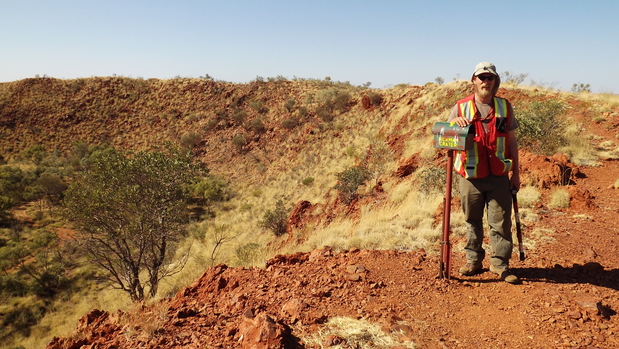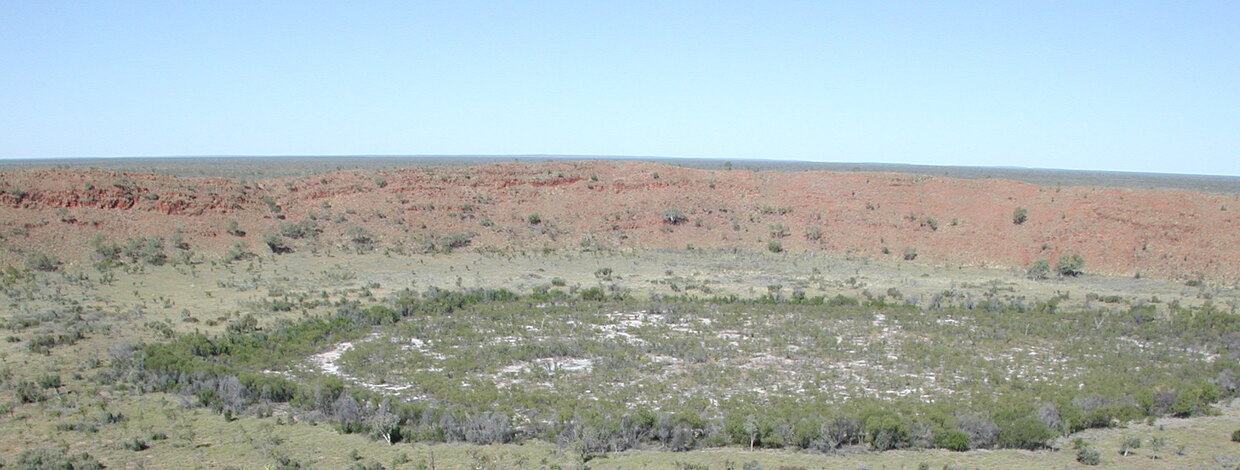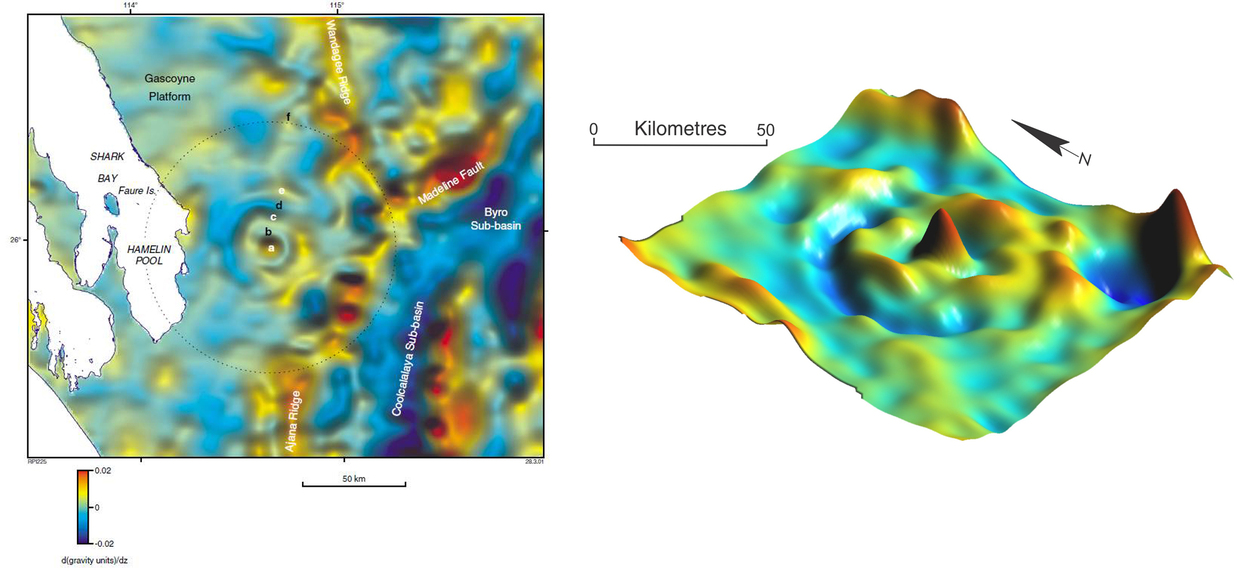In Western Australia, and the whole of Australia, sculpturing of the Earth is not confined to geological processes that require many thousands or even millions of years. In very rare instances, the present landscape was produced in seconds by meteorites or asteroids colliding with Earth. Some of the resulting structures are hidden under sediments but some are clearly recognisable as craters. All but the smallest were formed by explosions that greatly exceeded anything man-made.
Meteorite impacts in Western Australia
There are over a dozen impact craters or old eroded and buried impact sites referred to as ‘impact structures’ known in Western Australia. Most are not easily seen to the untrained eye, but some form remarkable geological features. Take a virtual tour of impact craters around the State. This is one of a series of GSWA StoryMaps.
Hickman Crater
In July 2007, Geological Survey of Western Australia (GSWA) geologist, Arthur Hickman, was using Google Earth to view the area north of Newman when he discovered a circular feature resembling a well-preserved meteorite impact crater. The feature is 260 metres in diameter and consists of a raised rim that encircles a flat densely vegetated floor. The inner slopes of the rim are very steep whereas the outer slopes are gradual. The crater is thought to be between 10 000 and 100 000 years old.

Arthur emailed images of the feature to Dr Andrew Glikson from the Australian National University (ANU) for a second opinion. Andrew agreed it resembled an impact crater. In August, Andrew made a field inspection of the crater, and quickly sent back a radio message that field evidence had convinced him it was indeed a meteorite impact crater. He proposed it be named ‘Hickman Crater’ to refer to the geological structure produced by the impact.
Arthur visited the crater in May 2008, and made additional observations, all of which supported a meteorite impact origin. In 2012, drilling established the original depth of the crater before it became filled with sand and clay. The true floor of the crater was intersected at a depth of 50 metres, making the total original depth of the crater 80 metres. Just above this floor, the drillcore contained impact breccia and melt glass produced by the intense shock and heating of the impact. About the same time as the drilling, small fragments of the meteorite were found on the crater rim.
Initial analysis of these fragments revealed that the meteorite was almost entirely composed of iron and nickel, but that minor amounts of other elements including cobalt and the platinum group elements (PGE) were also present. Studies are now well advanced to investigate the detailed chemical composition of the iron meteorite and to date the precise age of the impact using the Argon isotope method.
The following links provide more information about the Hickman Crater:
View the Hickman Crater in the State Meteorite Impact Structures Virtual Tour
Hickman Crater, Ophthalmia Range, Western Australia: evidence supporting a meteorite impact origin (article in Australian Journal of Earth Sciences)
Illustrated account by John Bunting
PowerPoint presentation: A newly discovered meteorite impact crater, Ophthalmia Range, Western Australia


Wolfe Creek Crater
Wolfe Creek Crater is a beautifully preserved simple impact crater and the main attraction of the Wolfe Creek National Park. The crater is a popular tourist destination, reached from the Tanami Road, about 145 kilometres south of Halls Creek in Western Australia’s remote southeast Kimberley region. The crater has a diameter of about 880 metres with the crater floor now about 55 metres below the rim, although at impact it was probably about 150 metres deep. A 50 metre diameter meteorite would be needed to produce such an impact. The crater is estimated to be about 300 000 years old.
See the following link for more information about the Wolfe Creek Crater:
View the Wolfe Creek Crater in the State Meteorite Impact Structures Virtual Tour

Woodleigh impact structure
Ancient impact craters that are now mostly eroded away or buried are referred to as impact structures. A huge impact structure known as Woodleigh — one of the largest discovered on the Australian continent — lies about 50 kilometres east of Hamelin Pool in the Southern Carnarvon Basin. Unfortunately it is buried by several hundred metres of younger sedimentary rocks. GSWA geologists have studied the impact crater by drilling, magnetic and gravity surveys (see gravity image of the structure) and seismic imaging. The size of the original crater has been controversial, but recent seismic data suggests it was about 51 kilometres in diameter. The age is not accurately known.
See the following links for other information about the Woodleigh impact structure:

Contact
For more information contact:
geoscience.mapping@dmirs.wa.gov.au
